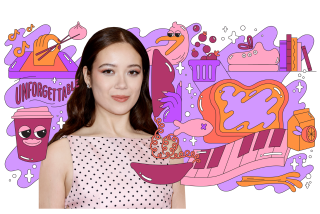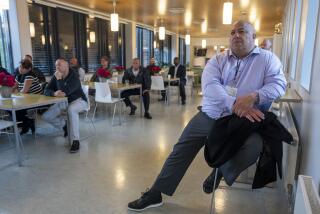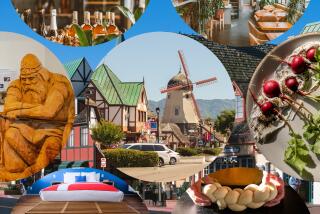Healthy Conviviality in Denmark
- Share via
TRANEKAER, Denmark — Looking more like a professional golfer on tour than an aristocrat, Count Preben Ahlefeldt-Laurvig swiveled his chair to the desk for a round of business.
The count has brought new ideas into the family’s old bloodline holdings that include a travel agency, a dairy farm, processing centers for fertilizer and plant food, timber mills.
The latest venture is furniture making, where he’s set up shop in this village on Langeland Island. The count’s handcrafted, inlaid wooden desk is made by his company, Tranekaer Furniture.
“Traditionally, Danish furniture is simple, made from light woods and really designed for Danes,” he said. “But we want to reach an international marketplace. So we’re using dark woods--mahogany, teak, cherry and walnut--and arranging the square chips into cubist-like table top designs, with the frame and legs suitable for contemporary or antique decor.”
Artisans Relocated
Recruiting cabinetmakers from all over Denmark, the count relocated 25 artisans to Tranekaer.
The village spreads around a towering 16th-Century red castle with park and ponds. About 250 people live here, and their half-timbered, thatched-roof houses contrast with the modern concrete structure housing the post office and a bank.
A yellow 19th-Century church under huge trees and a rustic-elegant guest house and restaurant dating to the 1800s add color and flavor to this quiet hamlet. Not long ago the castle owned everything around; gradually, though, the owners (the count’s family) began to sell off or rent parcels of land and houses.
Henni and Jan Starup, two artists who rent their neat farmhouse from the castle, told me about Sundgarden, a guest house that specializes in vegetarian dishes and offers programs in health care.
“Anybody in Denmark who’s a vegetarian or is health conscious knows the name Grethe Schmidt from her books or lectures,” said Jan Starup. “I’m very happy that she opened her place near us here.”
Baked Nut Steak Featured
Curious, I made a dinner reservation for a Sunday when the Sundgarden’s special baked nut steak is featured. It’s made from a puree of hazelnuts, sunflower kernels, whole wheat bread crumbs, raw carrots or celery root, cooked new potatoes, onions and vegetable stock and is seasoned with fresh basil and sea salt. It’s served with a fresh garden salad and a strawberry-banana cream dessert.
The place was packed. Most of the dinner guests were Danish and were staying for the week. After the meal I walked in the garden, through the village and down to the beach through the woods. It was a quiet evening, the air unpolluted, and an overwhelming, invigorating feeling swept me.
Instantaneously I decided to spend a week at Sundgarden. I felt that I could eat vegetarian for seven days, clean out my system and enjoy the simple country pleasures of Langeland Island.
The next day I met Grethe Schmidt, mother nature herself.
She seemed familiar, but I couldn’t quite place why; her mannerism and looks reminded me of someone famous. After a day of digesting my surroundings and raw vegetables, I recognized her as being a combination of Julia Child and the late Margaret Mead.
Grethe Schmidt is alive and well, very well. In her 60s, she looks 10 years younger. She has written five books, lectures 40 times a year and participates frequently in natural health seminars at home and abroad.
Absent-Minded Type
She also struck me as an absent-minded professor type, the kind who is an expert in her field but can’t find her notes. Fortunately, her daughter, Rie, sees that everything runs smoothly, supervises the kitchen, cooks, and does the food buying from the organic farmer. Sundgarden is a reflection of Grethe Schmidt, unpretentious and folksy.
A “Live and Let Live” poster hangs in the entrance hallway at Sundgarden. Guests are not reprimanded for their smoking habits or meat eating (although smoking is permitted outside only). About 5% of the guests are usually vegetarians. During my visit, only two out of 26 were strictly vegetarians.
Guests come from all walks of life, and that’s fine with Schmidt. She says she prefers a mix of people and doesn’t want health fanatics to stereotype Sundgarden as a haven for vegetarians only.
Both Peder Holm, 39, and his wife Birgit, 35, indulge in the good life. They’d heard about Sundgarden for some time, and decided impulsively one summer to visit from Copenhagen, which takes three hours by train and ferryboat.
It seemed ironic that Holm chose Sundgarden. He promotes Danish meat and dairy products as Far East manager of the Danish Agricultural Marketing Board in Tokyo.
Grethe Schmidt’s knowledge of natural health care comes from 40 years of experience and from raising two daughters and a granddaughter on organic vegetables and fruits, whole wheat grains and unrefined foods such as sugar, sea salt and olive oil.
Life at Sundgarden is like the place itself--simple. Breakfast at 8:30 a.m. consists of a bowl of Musli (flakes of wheat, barley and oats) soaked in a little water with raisins, shredded apple and topped with fresh fruit slices; whole wheat buns, herbal tea or coffee substitute.
Different Dish Each Night
For lunch, guests pack their own from a buffet spread with cooked vegetable casserole, salad, raw veggies, fresh fruit and home-baked bread. Dinner is served at 6 p.m. with a different dish each night during a week’s stay; herb tea, spring well water or organic apple juice for beverages. Milk and other dairy products not available.
After the evening meal, Schmidt, Rie or an invited guest (such as the Starups) discusses the merits of preventive medicine, vegetarian cooking and recipes, plants and herbs as food and medicine, or any topic of interest to the group.
There’s entertainment, too. Poetry and music recitals are given by house guests and village neighbors. There’s no radio or TV on the premises.
Schmidt, in essence, is an educator, a dedicated teacher who shows people how to maintain a healthy life and deal with stress through natural foods, physical exercise and immersing the soul and mind in arts, music and literature. To know Schmidt is to appreciate the natural beauty that Tranekaer and its surroundings offer. Tranekaer, according to her, is one of the most beautiful places in Denmark.
(According to Richard Estes, research director, University of Pennsylvania School of Social Work, Denmark is the best place in the world to live. Estes studied 107 nations measuring health factors, economic, political participation, stability, geographic variables, literacy, education, etc.)
Twenty minutes from Tranekaer is the island’s hub of Rudkobing, a 13th-Century town with cobblestone streets and half-timbered houses. Here is where H. C. Oersted, the discoverer of electromagnetism and inventor of scientific instruments, was born in 1777. The pharmacy his father owned still stands. Rudkobing is also the ferry port for passage to the islands of Aero and Stryno.
Pastoral Island
Langeland island is pastoral, with manicured rolling hills of corn, wheat and barley that edge out to sea. Patches of forest invite bicyclists and walkers into clearings where a few homes hide. Uncrowded beaches are close by. It is possible to walk along the coast of Langeland, which would probably take a week.
There’s the manor house Eggeloke, whose park is open to the public as is the one at Tranekaer Castle. Concerts and chamber music are performed at Tranekaer Church during summer.
The beautiful surroundings of Tranekaer perfectly complemented the vegetarian experience at Sundgarden. It seems the ideal place to live like a king or even a count.
Sundgarden Guesthouse: April through September, from $200 a week per person double, dormitory-style rooms; slightly more for singles; meals included. Slottsgade 10, Tranekaer, Denmark 5953.
Danish Tourist Board, 8929 Wilshire Blvd., Los Angeles 90211, (213) 854-1549.
More to Read
Sign up for The Wild
We’ll help you find the best places to hike, bike and run, as well as the perfect silent spots for meditation and yoga.
You may occasionally receive promotional content from the Los Angeles Times.






